KIA Soul 2016 2.G Owner's Manual
Manufacturer: KIA, Model Year: 2016, Model line: Soul, Model: KIA Soul 2016 2.GPages: 556, PDF Size: 21.35 MB
Page 541 of 556
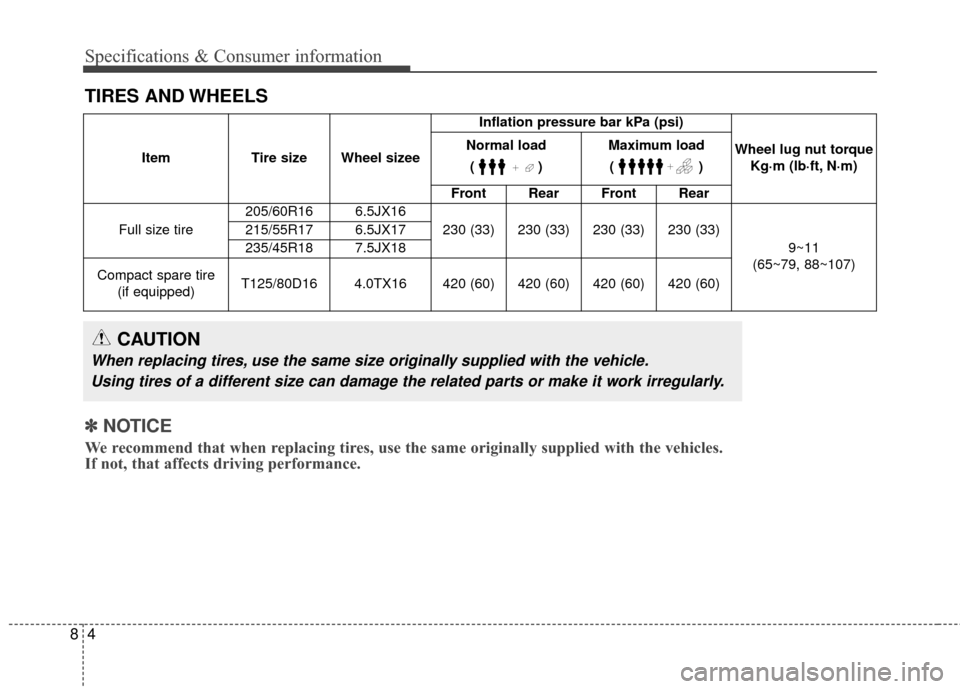
Specifications & Consumer information
48
TIRES AND WHEELS
CAUTION
When replacing tires, use the same size originally supplied with the vehicle.Using tires of a different size can damage the related parts or make it work irregularly.
Item Tire size Wheel sizee Inflation pressure bar kPa (psi)
Wheel lug nut torque Kg·m (lb·ft, N·m)
Normal load
()Maximum load()
Front Rear Front Rear
Full size tire 205/60R16 6.5JX16
230 (33) 230 (33) 230 (33) 230 (33)
9~11
(65~79, 88~107)
215/55R17 6.5JX17
235/45R18 7.5JX18
Compact spare tire (if equipped) T125/80D16 4.0TX16 420 (60) 420 (60) 420 (60) 420 (60)
✽ ✽
NOTICE
We recommend that when replacing tires, use the same originally supplied with the vehicles.
If not, that affects driving performance.
Page 542 of 556
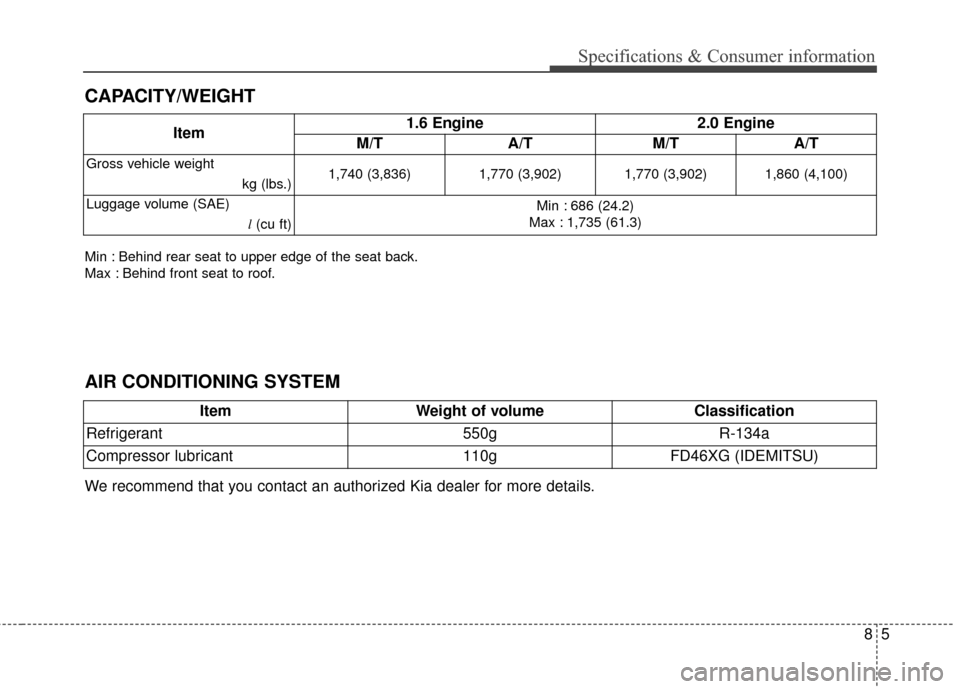
85
Specifications & Consumer information
CAPACITY/WEIGHT
Item1.6 Engine 2.0 Engine
M/T A/T M/T A/T
Gross vehicle weight
kg (lbs.)1,740 (3,836) 1,770 (3,902) 1,770 (3,902) 1,860 (4,100)
Luggage volume (SAE) l(cu ft) Min : 686 (24.2)
Max : 1,735 (61.3)
Min : Behind rear seat to upper edge of the seat back.
Max : Behind front seat to roof.
AIR CONDITIONING SYSTEM
ItemWeight of volume Classification
Refrigerant
550g R-134a
Compressor lubricant
110g FD46XG (IDEMITSU)
We recommend that you contact an authorized Kia dealer for more details.
Page 543 of 556
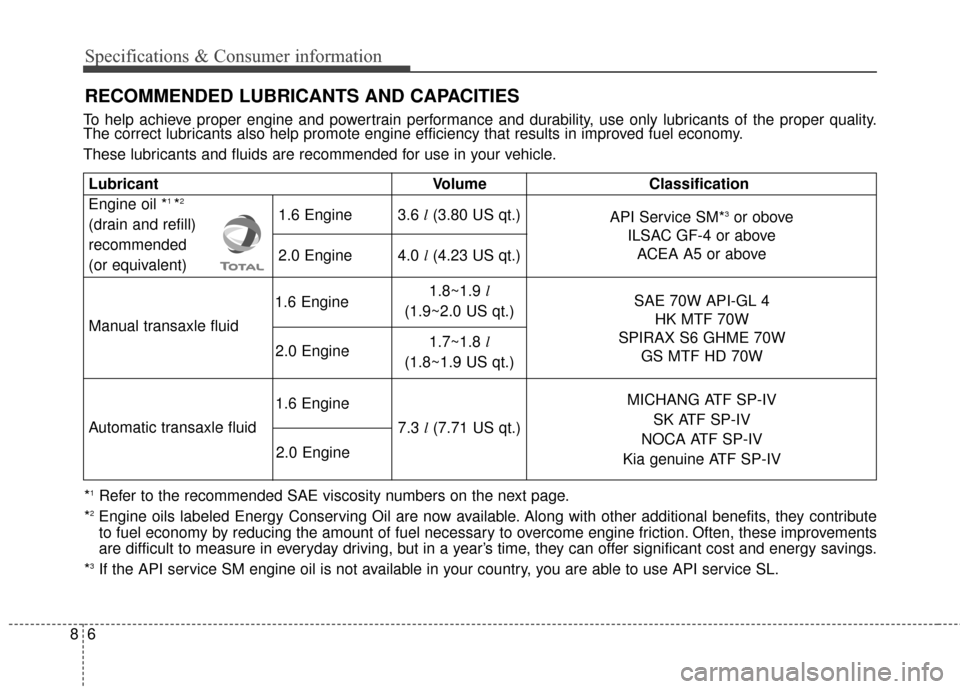
Specifications & Consumer information
68
RECOMMENDED LUBRICANTS AND CAPACITIES
To help achieve proper engine and powertrain performance and durability, use only lubricants of the proper quality.
The correct lubricants also help promote engine efficiency that results in improved fuel economy.
These lubricants and fluids are recommended for use in your vehicle.
LubricantVolume Classification
Engine oil *1 *2
1.6 Engine 3.6 l (3.80 US qt.)
(drain and refill)
recommended
2.0 Engine 4.0 l(4.23 US qt.)
(or equivalent)
Manual transaxle fluid
Automatic transaxle fluid
MICHANG ATF SP-IV
SK ATF SP-IV
NOCA ATF SP-IV
Kia genuine ATF SP-IV SAE 70W API-GL 4
HK MTF 70W
SPIRAX S6 GHME 70W GS MTF HD 70W
*
1Refer to the recommended SAE viscosity numbers on the next page.
*2Engine oils labeled Energy Conserving Oil are now available. Along with other additional benefits, they contribute
to fuel economy by reducing the amount of fuel necessary to overcome engine friction. Often, these improvements
are difficult to measure in everyday driving, but in a year’s time, they can offer significant cost and energy savings.
*
3If the API service SM engine oil is not available in your country, you are able to use API service SL. API Service SM*
3or obove
ILSAC GF-4 or above ACEA A5 or above
1.6 Engine
2.0 Engine
2.0 Engine
1.6 Engine
7.3 l(7.71 US qt.)
1.7~1.8
l
(1.8~1.9 US qt.) 1.8~1.9
l
(1.9~2.0 US qt.)
Page 544 of 556
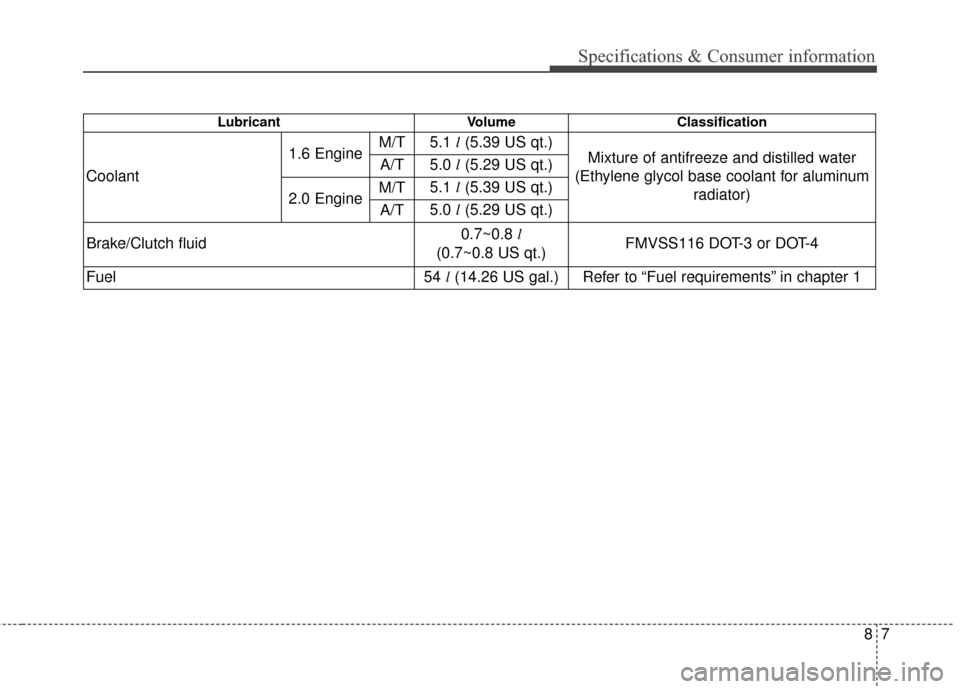
87
Specifications & Consumer information
LubricantVolume Classification
Coolant1.6 Engine
M/T
5.1
l(5.39 US qt.)
Mixture of antifreeze and distilled water
(Ethylene glycol base coolant for aluminum radiator)
A/T5.0 l(5.29 US qt.)
2.0 EngineM/T5.1 l(5.39 US qt.)
A/T5.0 l(5.29 US qt.)
Brake/Clutch fluid 0.7~0.8
l
(0.7~0.8 US qt.) FMVSS116 DOT-3 or DOT-4
Fuel 54
l(14.26 US gal.)
Refer to “Fuel requirements” in chapter 1
Page 545 of 556
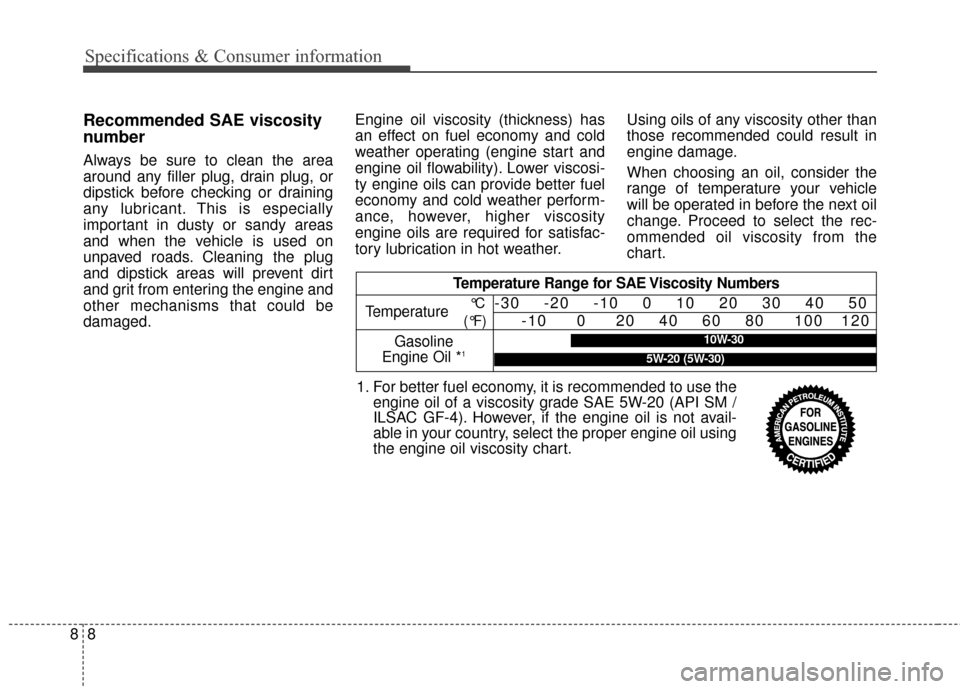
Specifications & Consumer information
88
Recommended SAE viscosity
number
Always be sure to clean the area
around any filler plug, drain plug, or
dipstick before checking or draining
any lubricant. This is especially
important in dusty or sandy areas
and when the vehicle is used on
unpaved roads. Cleaning the plug
and dipstick areas will prevent dirt
and grit from entering the engine and
other mechanisms that could be
damaged.Engine oil viscosity (thickness) has
an effect on fuel economy and cold
weather operating (engine start and
engine oil flowability). Lower viscosi-
ty engine oils can provide better fuel
economy and cold weather perform-
ance, however, higher viscosity
engine oils are required for satisfac-
tory lubrication in hot weather.
Using oils of any viscosity other than
those recommended could result in
engine damage.
When choosing an oil, consider the
range of temperature your vehicle
will be operated in before the next oil
change. Proceed to select the rec-
ommended oil viscosity from the
chart.
Temperature Range for SAE Viscosity Numbers
Temperature
Gasoline
Engine Oil *
1
°C
(°F)-30 -20 -10 0 10 20 30 40 50 -10 0 20 40 60 80 100 120
1. For better fuel economy, it is recommended to use theengine oil of a viscosity grade SAE 5W-20 (API SM /
ILSAC GF-4). However, if the engine oil is not avail-
able in your country, select the proper engine oil using
the engine oil viscosity chart.
10W-30
5W-20 (5W-30)
Page 546 of 556
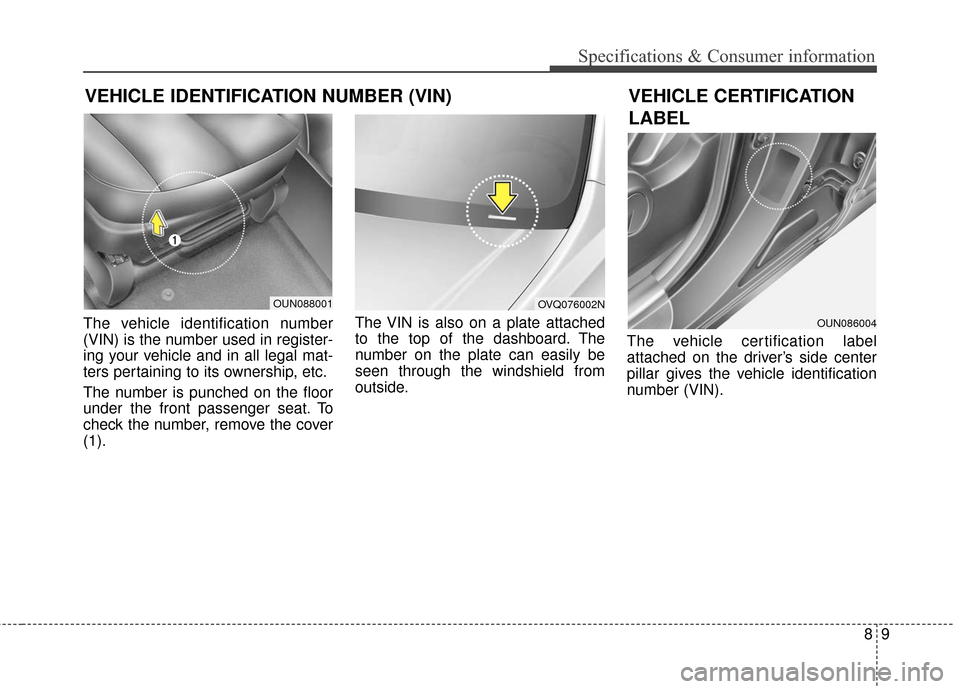
89
Specifications & Consumer information
VEHICLE IDENTIFICATION NUMBER (VIN)
The vehicle identification number
(VIN) is the number used in register-
ing your vehicle and in all legal mat-
ters pertaining to its ownership, etc.
The number is punched on the floor
under the front passenger seat. To
check the number, remove the cover
(1).The VIN is also on a plate attached
to the top of the dashboard. The
number on the plate can easily be
seen through the windshield from
outside.
The vehicle certification label
attached on the driver’s side center
pillar gives the vehicle identification
number (VIN).
OUN088001OVQ076002N
OUN086004
VEHICLE CERTIFICATION
LABEL
Page 547 of 556
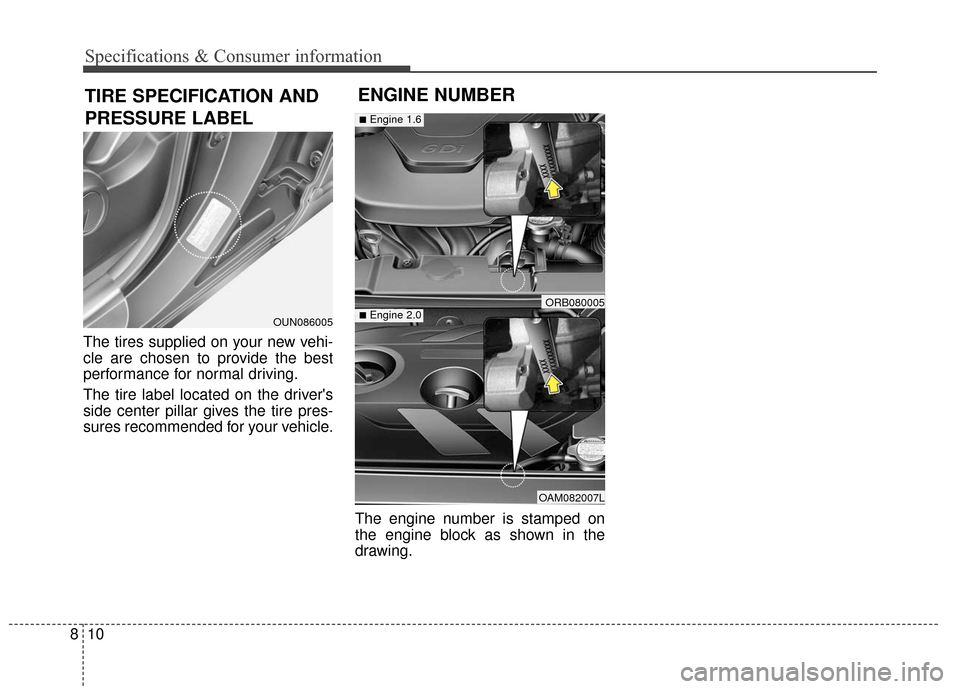
Specifications & Consumer information
10
8
The tires supplied on your new vehi-
cle are chosen to provide the best
performance for normal driving.
The tire label located on the driver's
side center pillar gives the tire pres-
sures recommended for your vehicle.
The engine number is stamped on
the engine block as shown in the
drawing.
ENGINE NUMBER
OUN086005
TIRE SPECIFICATION AND
PRESSURE LABEL
OAM082007L
■Engine 2.0
■Engine 1.6
ORB080005
Page 548 of 556
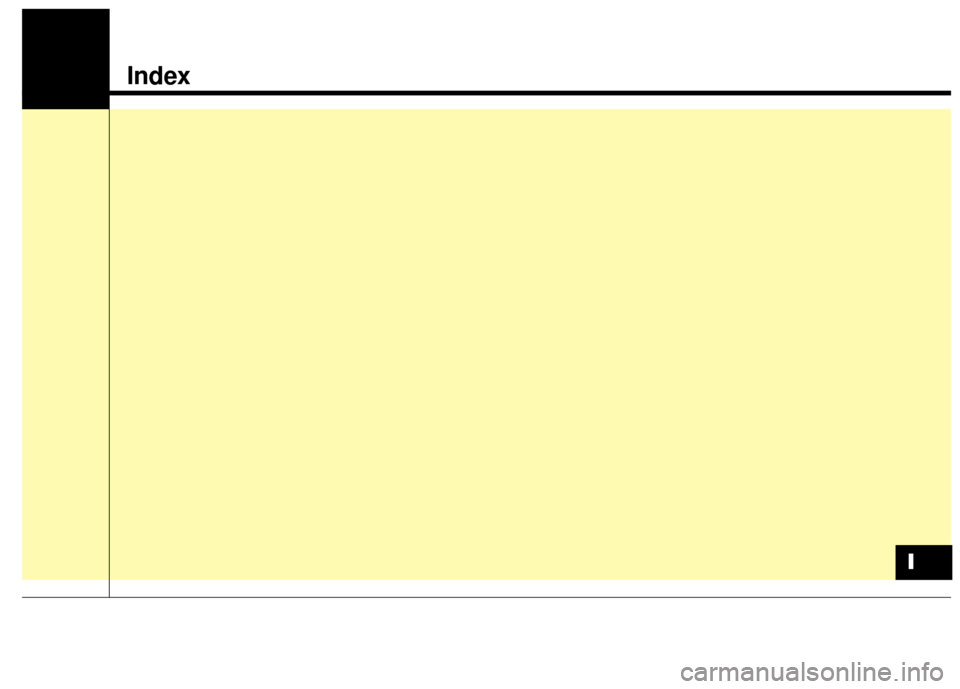
Index
I
Page 549 of 556
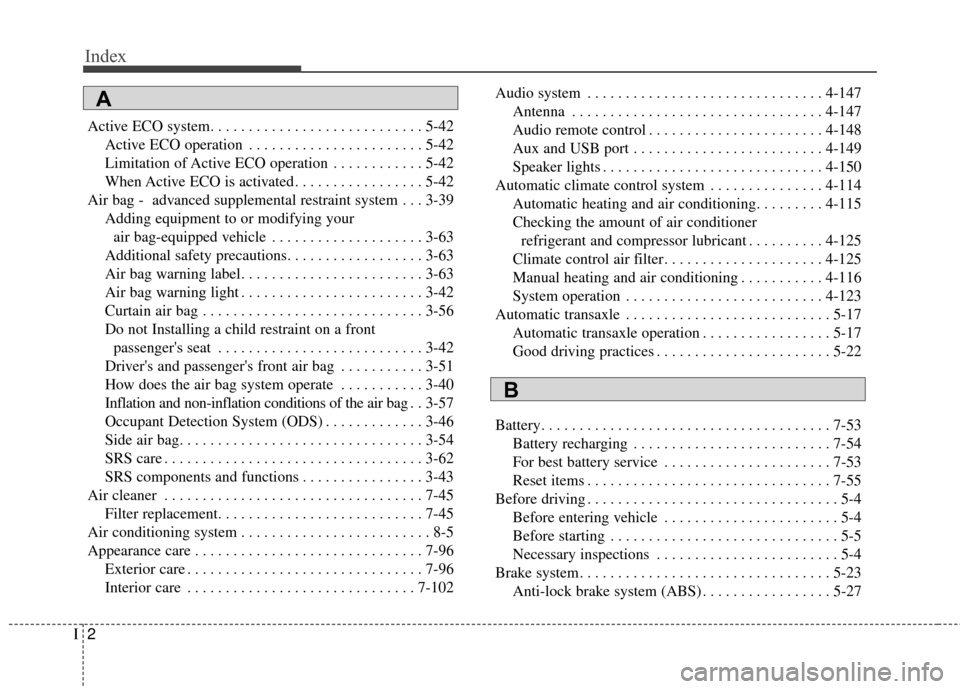
Index
2I
Active ECO system. . . . . . . . . . . . . . . . . . . . . . . . . . . . 5-42Active ECO operation . . . . . . . . . . . . . . . . . . . . . . . 5-42
Limitation of Active ECO operation . . . . . . . . . . . . 5-42
When Active ECO is activated . . . . . . . . . . . . . . . . . 5-42
Air bag - advanced supplemental restraint system . . . 3-39 Adding equipment to or modifying yourair bag-equipped vehicle . . . . . . . . . . . . . . . . . . . . 3-63
Additional safety precautions. . . . . . . . . . . . . . . . . . 3-63
Air bag warning label. . . . . . . . . . . . . . . . . . . . . . . . 3-63
Air bag warning light . . . . . . . . . . . . . . . . . . . . . . . . 3-42
Curtain air bag . . . . . . . . . . . . . . . . . . . . . . . . . . . . . 3-56
Do not Installing a child restraint on a front passenger's seat . . . . . . . . . . . . . . . . . . . . . . . . . . . 3-42
Driver's and passenger's front air bag . . . . . . . . . . . 3-51
How does the air bag system operate . . . . . . . . . . . 3-40
Inflation and non-inflation conditions of the air bag . . 3-57
Occupant Detection System (ODS) . . . . . . . . . . . . . 3-46
Side air bag. . . . . . . . . . . . . . . . . . . . . . . . . . . . . . . . 3-54
SRS care . . . . . . . . . . . . . . . . . . . . . . . . . . . . . . . . . . 3-62\
SRS components and functions . . . . . . . . . . . . . . . . 3-43
Air cleaner . . . . . . . . . . . . . . . . . . . . . . . . . . . . . . . . . . 7-45\
Filter replacement. . . . . . . . . . . . . . . . . . . . . . . . . . . 7-45
Air conditioning system . . . . . . . . . . . . . . . . . . . . . . . . . 8-5
Appearance care . . . . . . . . . . . . . . . . . . . . . . . . . . . . . . 7-96 Exterior care . . . . . . . . . . . . . . . . . . . . . . . . . . . . . . . 7-96
Interior care . . . . . . . . . . . . . . . . . . . . . . . . . . . . . . 7-102 Audio system . . . . . . . . . . . . . . . . . . . . . . . . . . . . . . . 4-147
Antenna . . . . . . . . . . . . . . . . . . . . . . . . . . . . . . . . . 4-147
Audio remote control . . . . . . . . . . . . . . . . . . . . . . . 4-148
Aux and USB port . . . . . . . . . . . . . . . . . . . . . . . . . 4-149
Speaker lights . . . . . . . . . . . . . . . . . . . . . . . . . . . . . 4-150
Automatic climate control system . . . . . . . . . . . . . . . 4-114 Automatic heating and air conditioning. . . . . . . . . 4-115
Checking the amount of air conditionerrefrigerant and compressor lubricant . . . . . . . . . . 4-125
Climate control air filter. . . . . . . . . . . . . . . . . . . . . 4-125
Manual heating and air conditioning . . . . . . . . . . . 4-116
System operation . . . . . . . . . . . . . . . . . . . . . . . . . . 4-123
Automatic transaxle . . . . . . . . . . . . . . . . . . . . . . . . . . . 5-17 Automatic transaxle operation . . . . . . . . . . . . . . . . . 5-17
Good driving practices . . . . . . . . . . . . . . . . . . . . . . . 5-22
Battery. . . . . . . . . . . . . . . . . . . . . . . . . . . . . . . . . . . . \
. . 7-53 Battery recharging . . . . . . . . . . . . . . . . . . . . . . . . . . 7-54
For best battery service . . . . . . . . . . . . . . . . . . . . . . 7-53
Reset items . . . . . . . . . . . . . . . . . . . . . . . . . . . . . . . . 7-55
Before driving . . . . . . . . . . . . . . . . . . . . . . . . . . . . . . . . . 5-4 Before entering vehicle . . . . . . . . . . . . . . . . . . . . . . . 5-4
Before starting . . . . . . . . . . . . . . . . . . . . . . . . . . . . . . 5-5
Necessary inspections . . . . . . . . . . . . . . . . . . . . . . . . 5-4
Brake system. . . . . . . . . . . . . . . . . . . . . . . . . . . . . . . . . 5-23 Anti-lock brake system (ABS) . . . . . . . . . . . . . . . . . 5-27
A
B
Page 550 of 556

I3
Index
Electronic stability control (ESC) . . . . . . . . . . . . . . 5-29
Good braking practices . . . . . . . . . . . . . . . . . . . . . . 5-35
Hill-start assist control (HAC) . . . . . . . . . . . . . . . . . 5-34
Parking brake - Hand type . . . . . . . . . . . . . . . . . . . . 5-25
Power brakes . . . . . . . . . . . . . . . . . . . . . . . . . . . . . . 5-23
Vehicle stability management (VSM) . . . . . . . . . . . 5-33
Brake/clutch fluid . . . . . . . . . . . . . . . . . . . . . . . . . . . . . 7-41 Checking the brake/clutch fluid level . . . . . . . . . . . 7-41
Bulb wattage . . . . . . . . . . . . . . . . . . . . . . . . . . . . . . . . . . 8-3
Capacity/Weight . . . . . . . . . . . . . . . . . . . . . . . . . . . . . . . 8-5
Child restraint system . . . . . . . . . . . . . . . . . . . . . . . . . . 3-30 Lower anchor system . . . . . . . . . . . . . . . . . . . . . . . . 3-36
Tether anchor system . . . . . . . . . . . . . . . . . . . . . . . . 3-35
Using a child restraint system . . . . . . . . . . . . . . . . . 3-31
Clean air . . . . . . . . . . . . . . . . . . . . . . . . . . . . . . . . . . . 4-\
131
Climate control air filter . . . . . . . . . . . . . . . . . . . . . . . . 7-47 Filter inspection . . . . . . . . . . . . . . . . . . . . . . . . . . . . 7-47
Filter replacement. . . . . . . . . . . . . . . . . . . . . . . . . . . 7-47
Cruise control system . . . . . . . . . . . . . . . . . . . . . . . . . . 5-37 Cruise control switch . . . . . . . . . . . . . . . . . . . . . . . . 5-38
To cancel cruise control, do one of the following . . 5-40
To decrease the cruising speed . . . . . . . . . . . . . . . . . 5-39
To increase cruise control set speed . . . . . . . . . . . . . 5-39
To resume cruising speed at more thanapproximately 20 mph (30 km/h) . . . . . . . . . . . . . 5-40 To set cruise control speed . . . . . . . . . . . . . . . . . . . . 5-38
To temporarily accelerate with the cruise control on . .
5-39
To turn cruise control off, do one of the following. . 5-41
Defroster . . . . . . . . . . . . . . . . . . . . . . . . . . . . . . . . . . . 4-\
102 Rear window defroster . . . . . . . . . . . . . . . . . . . . . . 4-102
Dimensions . . . . . . . . . . . . . . . . . . . . . . . . . . . . . . . . . . . 8-\
2
Door locks. . . . . . . . . . . . . . . . . . . . . . . . . . . . . . . . . . . 4-\
19 Auto door lock/unlock feature . . . . . . . . . . . . . . . . . 4-22
Child-protector rear door lock . . . . . . . . . . . . . . . . . 4-23
Impact sensing door unlock system . . . . . . . . . . . . . 4-22
Operating door locks from inside the vehicle . . . . . 4-20
Operating door locks from outside the vehicle . . . . 4-19
Speed sensing door lock system . . . . . . . . . . . . . . . 4-22
Economical operation . . . . . . . . . . . . . . . . . . . . . . . . . . 5-56
Emergency starting . . . . . . . . . . . . . . . . . . . . . . . . . . . . . 6-5 Jump starting . . . . . . . . . . . . . . . . . . . . . . . . . . . . . . . 6-5
Push-starting . . . . . . . . . . . . . . . . . . . . . . . . . . . . . . . . 6-7
Emission control system . . . . . . . . . . . . . . . . . . . . . . . 7-104
Engine . . . . . . . . . . . . . . . . . . . . . . . . . . . . . . . . . . . . \
. . . 8-2
Engine compartment. . . . . . . . . . . . . . . . . . . . . . . . . 2-6,7-3
Engine coolant . . . . . . . . . . . . . . . . . . . . . . . . . . . . . . . 7-38 Changing the coolant . . . . . . . . . . . . . . . . . . . . . . . . 7-40
C
D
E